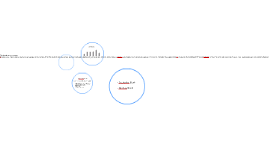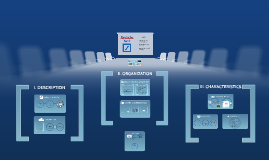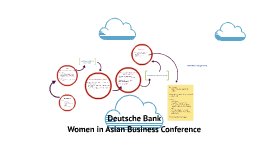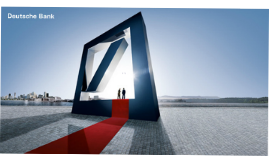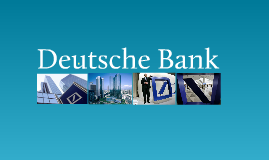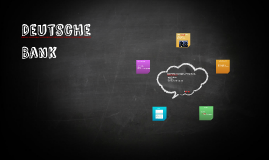Deutsche Bank
Transcript: Corporate Culture Core Businesses: Supervisory Board Economy Increasing governmental regulations Middle East crisis Supervisory Board (Chairmen) Social Responsibility: Founded in 1870 in Berlin, Germany Within 2 years Deutsche Bank had opened offices in Bremen, Yokohana, Shanghai, Hamburg & London Continuation of international expansion 1914: "biggest bank in the world" Liquidation of foreign branches due to WWI 1923-1930: Hyperinflation, mergence 1931: Economic Crisis occurs in Germany, forcing Deutsche Bank to allocate 1/3 of its resources to the state-owned bank, Golddiskontbank Tool for Nazi Party in WWII 1957: Deutsche Bank's branches merged once again to re-build company 1989: Deutsche Bank acquired Morgan Grenfell, giving the bank relations in New York City Today, Deutsche Bank remains a top leader in banking in Europe & is expanding its base in North America & Asia Current Mission: Dr. Josef Ackerman - Chairman of the Management Board and the Group Executive Committee Dr. Hugo Bänziger—Chief Risk Officer Jürgen Fitschen—Head of Regional Management worldwide Anshu Jain—Head of the Corporate & Investment Bank Stefan Krause—Chief Financial Officer Hermann-Josef Lamberti—Chief Operating Officer Rainer Neske—Head of Private and Business Clients Increase operations in successful Deutsche Bank branches, such as United States. Citigroup Commerzbank Credit Suisse Goldman Sachs Dr. Clemens Börsig—Chairman Karin Ruck*—Deputy Chairperson Gerd Herzberg*—Deputy Chairman Prof. Dr. Henning Kargermann—Former Chairman Maruice Lévy—Chairman and CEO, Publicis Groupe S.A Dr. Johannes Teyssen—Chairman of the Management Board Werner Wenning—Former Chairman of the Board of Management of Bayer AG Environmental, Social & Governance aspects of decision making Code of Business Conduct & Ethics provided to all employees for reading Current Strategies: Recovering economy Excellence Relevant Client Solutions Responsibility Growth Strategy: History Dr. Clemens Börsig—Chairman Karin Ruck*—Deputy Chairperson Gerd Herzberg*—Deputy Chairman Prof. Dr. Henning Kargermann—Former Chairman Maruice Lévy—Chairman and CEO, Publicis Groupe S.A Dr. Theo Siegert—Managing Partner Dr. Johannes Teyssen—Chairman of the Management Tilman Todenhöfer—Managing Partner Werner Wenning—Former Chairman of the Board of Management of Bayer AG Top Competitors Weaknesses: Strengths: Enterprise Value - €154,119,961,000 Market Capitalization - €38,598 Net Asset - €58.733 billion Income Statement Method - €12.630 billion P/E Ration - €188.187 billion Outstanding # of shares sold - €58,733,038,600 What a similar company sold for - $50 billion ≈ €34 billion Current Financial Value - €85,028,112,930 ≈ $126,117,917,325 Management Board History Citigroup - New York City Commerzbank - Germany Credit Suisse - Switzerland Goldman Sachs - New York City Group Executive Committee Current Values: Dr. Josef Ackermann—Chairman of the Management Board and the Group Executive Committee Dr. Hugo Bänziger—Chief Risk Officer Jürgen Fitschen—Head of Regional Management worldwide Anshu Jain—Head of the Corporate & Investment Bank Stefan Krause—Chief Financial Officer Hermann-Josef Lamberti—Chief Operating Officer Rainer Neske—Head of Private and Business Clients Kevin Parker—Head of Asset Management Robert Rankin—Chief Executive Officer Deutsche Bank Asia Pacific Werner Steinmüller—Head of Global Transaction Banking Seth Waugh—Chief Executive Officer Deutsche Bank Americas Pierre de Weck—Head of Private Wealth Management Committment to Sustainability, Corporate Volunteering, Social Investments, Art & Music and Education Taking brand and visual identity to the next level & underpinning strength out of economic crisis -Founded in 1870 in Berlin, Germany. -Within two years, Deutsche Bank had Bremen, Yokohama, Shanghai, Hamburg and London. -1914 "Biggest bank in the world" -Liquidation of foreign branches due to WWI -Hyperinflation during 1920s until economic crisis in 1929 -Forced to allocate 1/3 of funds to state-owned bank, Golddiskontbank -Used as tool for Nazi Party during WWII -Branches merged once again in 1957 for hopes of rebuilding -1989: Took over British bank Morgan Grenfell, allowing operations with New York's Banker's Trust “We compete to be the leading global provider of financial solutions, creating lasting value for our clients, our shareholders, our people and the communities in which we operate.” Corporate Structure: Divestiture of the Corporate Investments Product Division Corporate Governance Ethical Decision Making: Competitors: Withstood test of time Strong global operations Corporate & Investment Bank and Private Asset Management Deutsche Bank Retrenchment Strategy: Corporate Resources: Marketing Finance Research & Development Operations & Logistics Human Resources Information Systems Current Financial Value: Threats: Opportunities: (1) Corporate and Investment Bank (CIB) (2) Private Clients and Asset Management (PCAM) (3) Corporate Investments (CI) • Performance •






